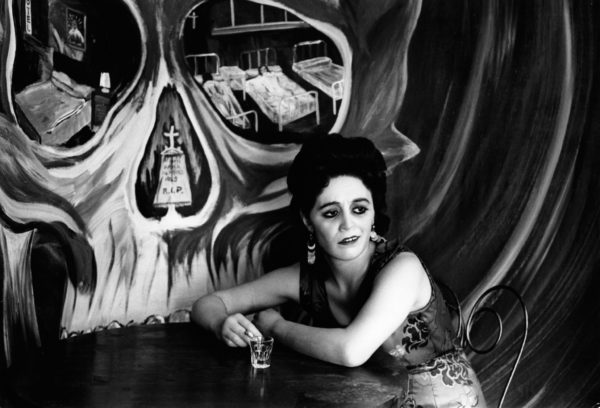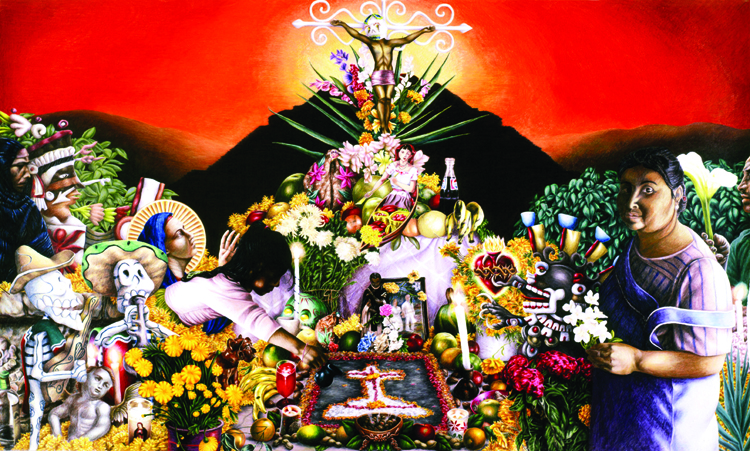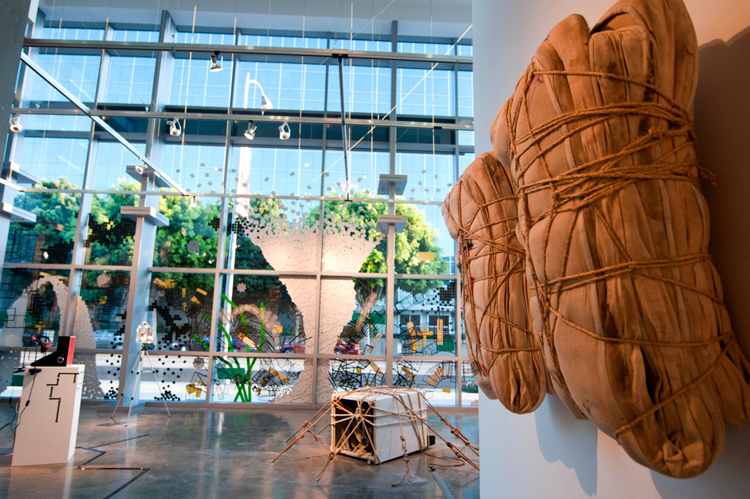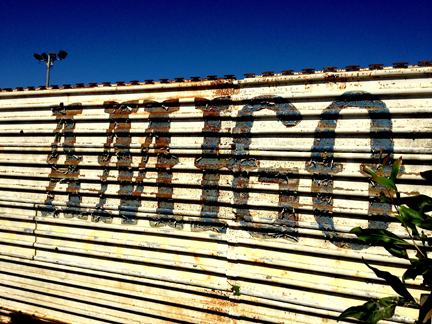Your cart is currently empty!
Tag: Mexico
-

Graciela Iturbide
The black-and-white magic of Graciela Iturbide‘s photography is difficult to capture in words. Through her lens, quotidian moments acquire an iconic, spiritual quality as life’s dichotomies and death’s mysteries lyrically play out in light, shadow, pattern, and expression. Sparkling with sharp tonality and subtle verve, dozens of her photographs in “Hay Tiempo” at ROSEGALLERY transport you to various parts of Mexico where you vicariously attend carnivals and catch glimpses of goat slaughters, meeting along the way an array of intriguing people including beekeepers, street vendors, barflies, brides, and Zapotec matriarchs. Something about the distrait lady imbibing before a ghastly mural in Mexico DF (1972, pictured above) brings to mind José Guadalupe Posada’s cynically grinning skeletons. Could that woman represent an agent of death, a soon-to-be-victim, or neither? Such ambiguity embedded in striking symbolism is part of Iturbide’s work’s beauty. Providing context, several photos by her mentor, Manuel Álvarez Bravo, hang alongside hers, as do paintings by Francisco Toledo, at whose invitation she traveled to Juchitán, Oaxaca and took several photos featured in this show. The exhibition’s Spanish title translates to “There is time,” a maxim Iturbide absorbed from Bravo, who urged her to slow down, observe, and patiently wait for the right moment to release the shutter. Decades later, her shots’ captivating nuance offers viewers ample pause.
ROSEGALLERY
2525 Michigan Ave., D-4
Santa Monica, CA 90404
Show runs through Apr. 20 -

MEXICO as MUSE
“Mexico is truly the promised land for abstract art.”
Anni & Josef Albers, 1936“Mexico is the most surrealist country in the world.”
Andre Breton, 1938Why Mexico? It was not only that Mexico was nearby and easily accessible to U.S.–based artists, although that was certainly true. And it was not just that Mexico had powerful ancient arts that were alien and mysterious to the Euro-American public, though that was true as well. It was also that Mexico was, in the 1920s, a significant cultural center. As historian Amy Lifson notes in “Art of Influence” from 2010, “[O]ne of the hottest venues in the art world was the Mexican Ministry of Public Education, where Diego Rivera was painting the frescoes that would revive mural painting in the West. Rivera was world-famous, considered one of the three great living artists—the other two being Picasso and Matisse. It took him seven years to paint the cycle, which consisted of 235 panels. Artists, intellectuals, students, and curiosity-seekers from all over came to see the work.” Rivera’s work employed a new stylistic language, combining the European avant-garde with Mexican indigenous traditions. The following is a short survey of artists and the years they were in Mexico, where they were inspired and transformed.

Tina Modotti, Mexican peasants reading El Machete, 1928, © The Estate of Tina Modotti EDWARD WESTON & TINA MODOTTI,
1923–27
Weston and his model/lover/muse Modotti sailed to Mexico in 1923, the year Rivera began his work at the Ministry of Public Education. They met the muralist, as well as his revolutionary colleagues and the woman who would become Rivera’s wife not once but twice, Frida Kahlo. The years in Mexico transformed both Weston and Modotti. Weston moved from Pictorialism to the hard-edged formalism of his great mature work. “How ridiculous a ‘soft focus’ lens in this country of brilliant light, of clean-cut lines and outlines,” he wrote in his Daybook. Modotti went from photographic subject to photographer in her own right, producing what may be the quintessential portraits of the newly empowered Mexican people.JUNE WAYNE, 1936
The same Ministry of Education that hired Rivera to adorn its walls gave Chicago-born June Wayne a grant to travel to Mexico City and produce an exhibition of Mexico-themed work. Two employees of the Ministry met Wayne at her first one-person exhibition, a series of small works she later called “execrable” abstractions. In Mexico, witnessing the painful difficulty of poverty and homelessness, she began the expressive figuration that initiated her Social Realist phase. Mexican critic Jorge Juan Crespo de la Serna wrote of “vehement sensitivity” and “perspicacity” in the work, concluding that Wayne was “on the threshold of a great triumph.” Indeed, Wayne returned to the United States, was hired by the Federal Art Project, flourished artistically and never produced another “execrable” canvas.ANNI & JOSEF ALBERS, 1936
I opened this essay with a quotation from a letter the Albers sent Wassily Kandinsky during their first trip to Mexico. “Mexico is truly the promised land for abstract art,” they wrote in 1936, “for here it has existed for thousands of years.” Josef created his first abstract oil paintings in Mexico. Anni incorporated elements drawn from serapes and temple facades into her designs. The 2007 exhibition “Anni y Josef Albers: Viajes por Latinoamerica” paired Albers abstractions with photographs of geometric configurations in pre-Columbian pyramids and indigenous back-strap loom textiles, clearly establishing the linkages. (Although they were in Mexico at the same time as June Wayne, the Albers did not meet her there. Years later, she invited both artists to come to Los Angeles and work at Tamarind Lithography Workshop.)ANDRÉ BRETON, 1938
The Pope of Surrealism came to Mexico as a cultural ambassador of the French government. He stayed with Rivera and Kahlo, traveled through native villages in Michoacan, collected folk art, and wrote a revolutionary tract with Leon Trotsky. He also curated an exhibition of Mexican Surrealism, including not only the magnificent double self-portrait Dos Fridas (painted specifically for Breton’s show), but also several stunning works by Manuel Alvarez Bravo (whom Breton, in his typical aggrandizing way, claimed to have “discovered”).Although Breton created a significant amount of visual art, he is much better known as a poet and artistic powerbroker. He should also be credited with putting Mexico at the center of the Surrealist map—and thereby attracting numerous non-Mexican artists to its “marvelous” terrain. Among the many European Surrealists who immigrated to Mexico and found inspiration in her welcoming arms were Luis Buñuel, Leonora Carrington, Wolfgang Paalen, Alice Rahon, and Remedios Varo.

Robert Motherwell, Poncho Villa, Dead and Alive, 1943 ROBERT MOTHERWELL, 1941
Although Motherwell had longed to be a painter, his father pressured him to do something “practical” instead. In 1940, he went to Columbia University to study with Meyer Schapiro and become an art historian. While in New York, he met and befriended many of the expatriate Surrealists, including Breton, whom he found “difficult,” and Chilean painter Roberto Sebastian Antonio Matta. He and Matta spent the summer of 1941 in Mexico. Motherwell later said (in his oral history for the Archives of American Art), “It was there that I really seriously started painting. And wrote my father that I was going to quit school and paint. By that time he was beginning to feel that everything might turn out all right […] So he said, ‘Fine, if that’s what you want to do, do it and I’ll give you your fifty dollars a week.’”RUTH ASAWA, 1945-47
Asawa left the wartime Japanese interment camp her family resided in to go to teachers’ school and then on to Black Mountain College. There she studied with the Albers, among others. She traveled to Mexico in 1945 and again in 1947. On her second trip, she learned the crocheting technique that she would later use for her astonishing wire sculptures.
HANS BURKHARDT (1904-1994)
BURIAL OF GORKY, 1950
Oil on Canvas
Collection: Philadelphia Museum of Art
Courtesy: Jack Rutberg Fine Arts, Los AngelesHANS BURKHARDT, 1950-68
Burkhardt traveled to Mexico in 1950, soon after hearing of the death of Arshile Gorky, his teacher, friend and frequent collaborator. It was there that he found the visual language to deal with the devastating personal loss. Inspired by Mexican funerals and cemeteries, he began two of his seminal series: “Burial and Journey into the Unknown.” Burkhardt returned to Mexico again and again, sometimes staying as long as six months. It was in 1968 that he began to work with the discarded skulls he had collected in Mexican cemeteries. (At that time, when families could no longer make payments on graves, the tomb was emptied and the bones piled at the rear of the cemeteries.) Affixing the skulls to a large canvas, Burkhardt created what may be his masterpiece: a protest of the Vietnam War entitled My Lai. In the catalog to Burkhardt’s “Black Rain” exhibition, art historian Donald Kuspit describes My Lai “among the greatest war paintings.”
J.Michael Walker, Zan ca tlaquetchol (Portrait of Mascara Roja), 1994
Color pencil on rag paperJ. MICHAEL WALKER, 1974 to present
Walker was attending art school in Oklahoma when he was hired to travel to Sisoguichi, Chihuahua, in Northern Mexico and work as illustrator of what would become the first textbook in the Tarahumara language. His first day in the tiny village, he met the young woman who would become his wife. Walker was scheduled to be in Sisoguichi two weeks, but ended up staying eight months. He found himself spiritually and culturally reborn: “Everything I’ve done since then I attribute to that blessed ‘bump on the head’ encounter. I was at a dead end. Mexico gave me a template for understanding life and moving on.” Walker drew with color pencil in large sketchbooks, creating portraits and interiors that would become the basis for his contemporary practice. He copied pre-Columbian warriors from a reproduction of Codex Nuttall, colonial sculptures from the local church, and saints from the chromolithographs Sisoguichans hung on their walls.This list could be much more extensive. I could, for example, mention Lari Pittman and Roy Dowell, who have traveled to Mexico regularly since the late 1970s, noting that Mexican motifs appear in both of their works. I could talk about the Mexican precedents for Peter Alexander’s black velvet paintings. Or I could discuss the Mexican viceregal sources of so much of Matthew Couper’s oeuvre. But I must draw this to a close, so I will discuss only one more person for whom Mexico served as muse.
CODA: Mexico as My Muse
When I was a little girl, my favorite television program was Howdy Doody. As a female viewer, my strongest identification was with Princess Summerfall Winterspring. (The “Indian” princess was portrayed by “white” actress Judy Tyler, an irony I did not understand until much later.) Throughout my childhood, I dressed as Summerfall Winterspring, wearing a short fringed dress, moccasins, beads and headband to birthday parties and Halloween. (Imagine how silly this looked on a little girl with curly red hair and freckles.) In college, the Indian princess look morphed seamlessly into Hippie attire: I wore fringed jacket, moccasins, love beads and headbands all over again.When I decided to go to graduate school in art history, I specialized in pre-Columbian and Native American art. I traveled repeatedly to Mexico, doing research in Mexico City and Oaxaca and visiting every major pre-Columbian site. I loved the people. I loved the food and became addicted to really hot chiles. I was seduced by the raw power of Aztec sculpture, recognizing the truth of the fierce feminine in Coatlicue. I was enraptured by the sheer beauty and grace of Palenque and the magnificence of Monte Alban. I was fascinated by the elegance of Mayan relief carvings and the precision of Mixtec jewelry. I collected folk art, especially wooden dance masks and traditional women’s clothing. When I began teaching, I wore Mixtec or Maya huipiles over jeans, hanging Zapotec earrings in the holes I pierced myself.
It wasn’t until I moved to California and found myself in a politically charged Chicano world that I began to understand the troubling racial politics of a white woman wearing indigenous attire. I stopped wearing huipiles and, eventually, I stopped teaching Native American and pre-Columbian art history. It no longer felt “right” to be a white person who was explaining—and thereby controlling the knowledge of—other cultures. Once I read Craig Owens’ “The Indignity of Speaking for Others,” I understood why. (Owens’ seminal essay is included in his Beyond Recognition: Representation, Power and Culture, 1992.) When I read about what is called Primitivism, especially as it applies to artists like Paul Gauguin, I realized that in my Summerfall Winterspring and hippie days, I had been something of a Primitivist, someone who turns away from her own culture to find answers in the Other.
I do not mean to say that my attraction to Mexico can be reduced completely to Primitivism. The clash of Mexico and U.S. cultures fueled my intellectual life. When I studied Mexican and Native American societies in graduate school, I learned about culture change and cultural difference. (I got my Ph.D. at the University of New Mexico—the perfect place for such studies.) Writing about Mexico led me to explore not only Said and Owens, but also writers as varied as Structuralist anthropologist Claude Levi-Strauss and Phenomenologist Merleau-Ponty.
My journey through Mexico has been a journey from consumption to critical thinking. Just as Mexico turned Edward Weston into a sharp-focus photographer, Josef Albers into an abstract painter and June Wayne into a Social Realist, it changed me from an art historian trained in stylistic analysis to an eclectic Postmodernist. (And I’m still addicted to chiles.)
-

MEXICO al MAXIMO
The Museum of Latin American Art in Long Beach calls itself, “The only museum in the United States exclusively dedicated to modern and contemporary Latin American art.” Yet its permanent collection is comprised largely of works from Mexico, with exhibitions often featuring art from that country. Idurre Alonso, curator there since 2002, talks about the “aestheticism” of contemporary Mexican art that is on a par with that from the United States and Europe. She credits this in part to Mexico’s comprehensive support of the arts. “The country gives out so many grants that emerging artists are able to live largely on grant money.” She adds that the government supports most museums, freeing them to devote energy to exhibitions, while Mexican citizens are usually admitted for free. “On weekends, museums and galleries are filled with families of all classes,” she says, adding, “Art there is not just for the elite.” Mexico’s support for the arts goes back 100 years to when the government subsidized its murals, regarding them as tools for education about the country’s history.
Alonso grew up in the Basque country of Spain with art-loving parents and grandparents. As a child, she frequented the local Bilbao museum and later the Guggenheim Museum there. While in college, she interned at MOLAA, developing a passion for Latin American art, and began working there after graduation. Since starting there, Alonso and the staff have been working toward connecting Latin American art with that of disparate locales, creating exhibitions with a more universal approach.

Dream Addictive, Solar Sound/Sonido solar, 2010, at MOLAA Alonso curated “Descartes” in 2010, showing work by Mexican artists who emerged into the Tijuana-based international art scene in the late 1990s. The Collaborative Gallery (jointly owned by MOLAA and Long Beach) exhibition featured “readymade” objects, exploring Mexican-related issues such as immigration, exploitation, consumerism and the environment. UCLA graduate Camilo Ontiveros’ Deportables/Mattresses, constructed from discarded mattresses, bound in rope and hung on the wall, and his Restrained (both, 2008), a beat-up washing machine on its side, depict the selling of cast-off objects in Mexico at outrageous prices. Solar Garden (2010) by Dream Addictive (the art collective, Leslie García and Carmen González) employs recycled electronic and solar-powered equipment, demonstrating that even solar material is discarded in our throwaway world. Jaime Ruiz-Otis’ Untitled (2010) is a landscape made from discarded industrial stickers and labels.
At our meeting, Alonso pulls out three MOLAA exhibition catalogs, providing historical reference for contemporary Mexican art. “Mex/L.A. ‘Mexican’ Modernism(s) in Los Angeles, 1930–1985” explored the relationship between artists and supporters on both sides of the border. The show included descriptions of Los Angeles murals by José Clemente Orozco and David Alfaro Siqueiros and graffiti art by Chaz Bojorquez. There was also Disney animation inspired by Mexican culture, including The Three Caballeros (1945) starring Donald Duck. Pieces in this show, largely from the “Mexican modernism” era, often incorporate influences from primitive and unschooled artists—a trend persisting in Mexican art today.
The museum’s 2011 “Mexico: Expected/Unexpected,” with modern and contemporary paintings, photography, installation, video art and sculpture from Latin America, Europe and the United States, included works by Mexicans Carlos Amorales and Manuel Álvarez Bravo, and by Americans Ana Mendieta (born in Cuba) and contemporary artist Ed Ruscha. Amorales’ Panorama (2007), large collage drawings with stark images of birds, apes, humans and hybrids depicts violence in humans and animals. These were hung near Mendieta’s equally dark On Giving Life (1975), a photograph of the artist lying naked in the grass atop a skeleton.
“Changing the Focus: Latin American Photography 1990–2005” (2010), curated by Alonso, demonstrated how “Latin American photography took its rightful place within the international contemporary art scene,” as the catalog explains. It explored current social, political and economic perspectives of Latin American photographic art. Death by Tupperware (2005) by Daniela Edburg from Mexico, of a woman in her kitchen being strangled by a monster arising from a plastic container surrounded by American convenience foods, is a metaphor for the perceived strangulation of Mexico by the U.S. and its processed products. Two elegant images by Mexican Daniela Rossell, from her 2002 “Rich and Famous” series, portray wealthy Mexican women in palatial estates, both homes lavishly appointed with Latin and European décor. These photos, referencing iconic Renaissance paintings, provide a window into this (nearly oligarchic) country’s embrace of styles and cultures far beyond its borders.
“This region’s art is as relevant today as that in Europe and North America,” Alonso explains, adding, “In the 20th century alone, Latin American artists have worked in surrealism, social realism, abstraction, conceptualism and more.” With so many artists and movements to present, her goal is to continue to create significant exhibitions and catalogs—to foster worldwide understanding of Latin American and Mexican art.
-

CURFEW: WE DON’T NEED NO STINKIN’ WALL
Heaven’s gate doesn’t separate life and death like the U.S.-Mexican border. And if the rhetoric and rifles weren’t forcibly obvious symbols, the new pedestrian crossing from San Ysidro into Tijuana is unambiguously penal. A cattle stockade.
While the debate over the fence rampages 2600 miles away, Tijuana residents have taken to the fence itself to illegally add their voices. In two main sections—near the airport and into the Pacific—the wall sprouts messages in any medium that will stick. The surfeit of English, in places few Americans actually go (it’s not a chic Tijuana location), seems peculiar until the random words and images form a complete book. To us. The only sentiment missing is an “Abandon all hope, ye who enter here.” I’m just not sure which side it should be graffitied on.
[slideshow_deploy id=’1209′]








